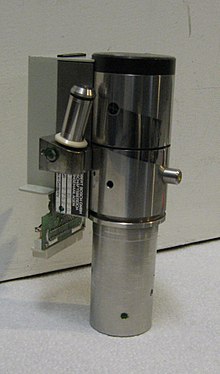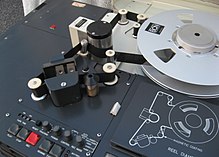 Type B videotape, one hour reel | |
| Media type | Magnetic Tape |
|---|---|
| Encoding | NTSC, PAL, SECAM |
| Capacity | Up to 2 hours (120 Min.) |
| Read mechanism | Helical scan |
| Write mechanism | Helical scan |
| Standard | Interlaced video |
| Developed by | Bosch Fernseh |
| Dimensions | 1 Inch reel to reel |
| Usage | Video production |
1-inch Type B Helical Scan or SMPTE B is a reel-to-reel analog recording video tape format developed by the Bosch Fernseh division of Bosch in Germany in 1976. The magnetic tape format became the broadcasting standard in continental Europe, but adoption was limited in the United States and United Kingdom, where the Type C videotape format met with greater success.[1][2][3][4]
The tape speed allowed 96 minutes on a large reel (later 120 minutes), and used 2 record/playback (R/P) heads on the drum rotating at 9,000 RPM with a 190-degree wrap around a very small head drum, recording 52 video lines per head segment. A single video frame or field was recorded across 6 tracks in the tape. The format only allowed for play, rewind and fast forward.[5] Video is recorded on an FM signal with a bandwidth of 5.5 MHz. Three longitudinal audio tracks are recorded on the tape as well: two audio and one Linear timecode (LTC) track.[6][7][8] BCN 50 VTRs were used at the 1980 Summer Olympics in Moscow.[9]
The format required an optional, and costly, digital framestore in addition to the normal analog timebase corrector to do any "trick-play" operations, such as slow motion/variable-speed playback, frame step play, and visible shuttle functions. This was because, unlike 1-inch type C which recorded one field per helical scan track on the tape, Type B segmented each field to 5 or 6 tracks per field according to whether it was a 525- (NTSC) or 625- (PAL) line machine.[10]
The picture quality was excellent, and standard R/P machines, digital frame store machines, reel-to-reel portables, random access cart machines (for playback of short-form video material such as television commercials), and portable cart versions were marketed.[11][12]
Echo Science Corporation, a United States company, made units like a BCN 1 for the U.S. military for a short time in the 1970s. Echo Science models were Pilot 1, Echo 460, Pilot 260.[13][14][15]

